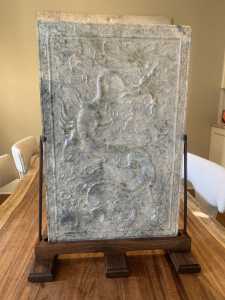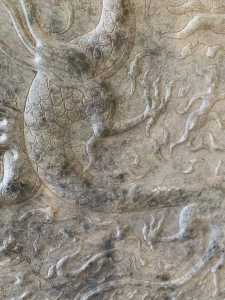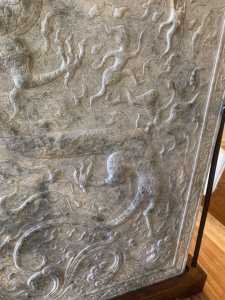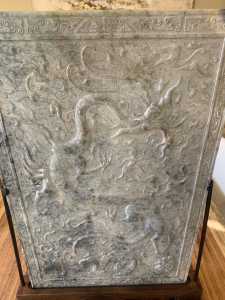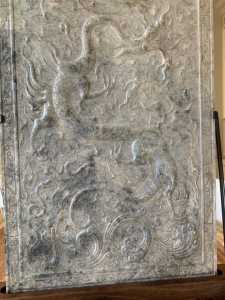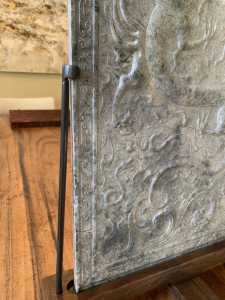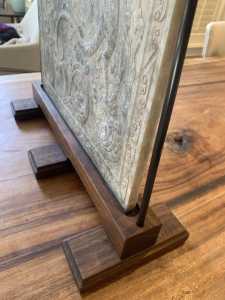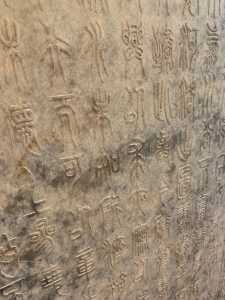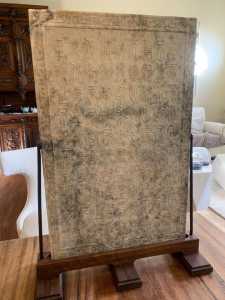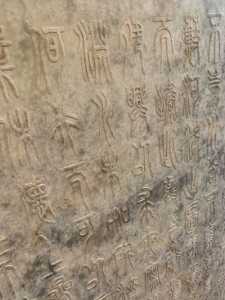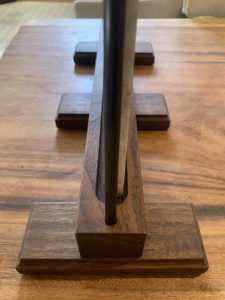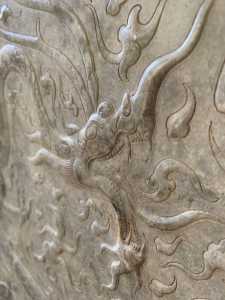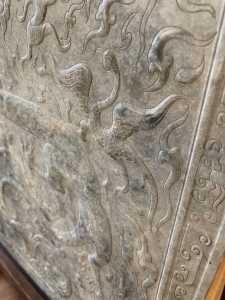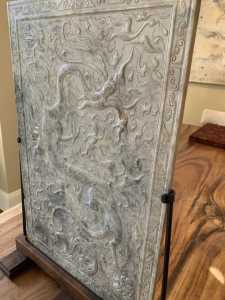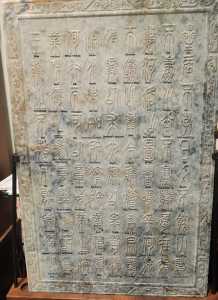The Chinese and Asian Art Forum. For Fans, Collectors and Dealers.
 Basic Rules For the BidAmount Asian Art Forum: Talk about whatever you want. You can even discuss and offer things that are for sale if they are authentic. Maximum image file size per post is 2 MB. Images of 700pxl x 700pxl are optimal if saved at a medium resolution. Be respectful of others and enjoy yourself. Click the YouTube link for a brief tutorial on using the forum. You can also EMBED Videos by cutting and pasting from You-Tube, Vimeo etc.
Basic Rules For the BidAmount Asian Art Forum: Talk about whatever you want. You can even discuss and offer things that are for sale if they are authentic. Maximum image file size per post is 2 MB. Images of 700pxl x 700pxl are optimal if saved at a medium resolution. Be respectful of others and enjoy yourself. Click the YouTube link for a brief tutorial on using the forum. You can also EMBED Videos by cutting and pasting from You-Tube, Vimeo etc.
NOTE: To post an item or add a new post, click open the category title from the FORUM LIST, and CLICK the Blue ADD TOPIC button.
I picked up this large jade tablet not too long ago ( 22.5” x 14.5” x 3/4” thick ) from antique dealer. The background on the piece is that it's from a very wealthy man's grandfathers' collection that recently passed. There are 5 other tablets very similar to this one, and all depict dragons with this ancient script on the back. My current attempt to translate it took about a week, but I'm uncertain it's accurate as this is my first time ever translating Chinese.
My best guess is that it translates to part of the following (Source: The text was originally from 漢書武帝紀 Book of Han, Annals of Emperor Wu):
"The stars will not fade, the sun and moon will not eclipse, the mountains will not collapse, and the rivers and valleys will not be blocked. Linfeng is working in the suburbs, and Heluo is publishing books. Woohoo! How can one achieve this?
Today, I have been granted the title of Fengzong Temple. I have been seeking for it for a long time, and I sleep hard at night thinking about it. I am like wading into the deep water, and I don’t know how to help. How great! What can be done to highlight the great deeds and virtues of the late emperor? I join Yao and Shun at the top, and the three kings at the bottom. I am not sensitive enough to be virtuous, and this is what the great officials have seen and heard."
-
Is there any way to tell who wrote this or commissioned it? Perhaps this may be commisioned by an Emperor?
-
Would anyone know the time period? The oxidation/crystallization of the jade (white spots) would indicate it is extremely old. The black spots may be from human fluids (blood, etc) if it was buried with someone. I found a jade tablet with similar or the same language inscribed on it which is claimed to be from 475-221 BC. It also has a similar crystalized patina: https://www.schneiblefinearts.com/shop/chinese-fine-art/china-ancient-jade-set-four-engraved-tablets-475-221-bc/
This type of object is almost always modern. The surface can be artificially made to look old. They treat them with chemicals etc. Perhaps Mark will add his thoughts as he is well versed in jades, but I would assume this is brand new.
This would need to be seen and handled in person.
I have no idea what the inscription is or who ordered it etc
Archaic jade's are not my area. But I am very very cautious when I see perfect curves and circles.
Mark
Yes, what I've learned is that you want to look for crystalization in every cut line, otherwise it's likely chemically treated and/or sandblasted. This has the crystalization like you'd want to see, as well as some other indicators like the tiny black spots (iron deposits), and "tomb smell".
My main concern with the piece is that it's done in relief style. Since this is not a very common style for jade carving, in my opinion that tells me it was done by someone very important during that time, or with modern machines. I've taken a loop to it, and it appears to have the proper cut lines that indicate older tool sets were used to carve it, but I am not an expert.
The 'relief style' as you put it was used during the 1950's by the communist government to increase profits etc. Also acid etched plaques were very popular.
The quality of this work was outstanding and not just jade's but also copies of other stuff. There was a special section that dealt with jade's but I can't remember the name and I have lost my reference note books a couple of years ago when I was moving.
The issues with modem drilling are further combated when such are heavily polished to try to hide said technique.
However when ones sees perfect circles, perfect curves, crossed lines, stuttered lines then one needs to be very careful. Also the finer details are often overlooked for money reasons. Older carvers took immense pride in their work and would often spend huge amounts of time to create a carving.
The old polish technique I don't think you can fake. They are using modern polish techniques that are completely different from the older ways. This is very evident when you see new nephrite pieces for sale.
Crystalization can and has been faked before both on jade's and bronzes. I am not sure about tomb smell. Or even what the smell would be.
As you know archaic jade's are very sought after and can command huge prices.
I get a lot of people sending me images of archaic jade's to seek my opinion and I nearly always refrain from giving my opinion unless it's obvious because I don't deal with these at all.
This is because it's fairly simple to recreate or copy archaic jade carving like the famous pig style carving. It's much more difficult to recreate or fake later Ming or Qing jade's. This of course is just my opinion.
The plaque that you have posted is very nice looking but I am not convinced it's old. But that's just my gut feeling when I first saw the post.
Sorry for the long response.
Mark
@imperialfinegems I appreciate the insight and detailed response. You mentioned that the 'old polish technique' is more difficult to fake. What should I look at to get a better idea if it's an older technique or a newer one for polishing?
The piece is extremely well carved & polished. I've done countless searches and whatnot for similar pieces, fakes, ect, and haven't found a single one. So one thing I'm confident on is that it's certainly unique.
In regards to the "tomb smell", it basically means the jade has a bad odor, and implies it was burried with a person.

If jade has such tomb smell, it would imply it to be as old or older than the Han dynasty based on what I've seen online (~200 BC or older).
Yes Brian I agree with you that is very well carved.
To determine the polish technique is difficult to explain.
One way that the old traders used to do was spit on the jade and see if there finger moved easily over the wet part with applied pressure. According to them the newer jade's would be more difficult to do this than the old jades.
Newer jades have a very shiny appearance. Older do not have the same shiny look. More of a subdued look.
If this makes sense to you.
I am sure you as a jade collector have seen this difference over the years.
Mark
@imperialfinegems Yes, that makes total sense. I have some immitation archaic jade pieces that are noticeably harder to move a wet finger across than this tablet in discussion. The immitation pieces also don't have the bad odor I mentioned and are more shiny.
My guess as to why the finger trick is used may be is because archaic nephrite has had more time to absorb matter, and "smooth" out so to speak. I imagine similar to plugging a bunch of tiny holes so that when a when your finger slides across it, it's essentially gliding on the plugged surface.
Is there anyone you'd reccommend I have look at it in person? It sounds like that would be the only way to tell for sure if it's archaic or not
I assume that you are in the USA?
Unfortunately not. The only person that I used was Sam Bernstein from time to time. But unfortunately he passed away a few years ago from Covid.
There is another member here but I can't remember his user name.
It's a complicated area of collecting. More so than porcelain and definitely more problematic with archaic jade's.
You could try the major auction rooms. But that's more of a hit and miss scenario.
Perhaps if others remember him. He did not post often etc.
Sorry again that I couldn't be of help.
Mark
Oh, Brian you know the lick the jade or lick your finger technique. That's great.
Not many people do actually know this technique as the older jade dealers are long gone.
Mark
Yes, I'm in the DC area. Ah ok, bummer. It's exceedingly difficult to find an expert for archaic jade. I've tried a local museum and Bonhams, but neither were responsive.
Thank you for your input & time, I appreciate it.
@soccertechie we have a forum member who lives in the DC area. Perhaps he can recommend someone for you. I'll ask him.
Hi Brian,
John reached out to me, sorry it took a few days to pop on here. I'm in Bethesda used to work in Georgetown, so right up the road.
I am curious if you purchased this from a dealer in this area, because from where I sit, there are zero dealers here that I would purchase such a thing from. There are dealers who would inadvertently sell you this but not one with the knowledge to sell you this. I won't name and shame anyone in particular on the forum, though I have commented in the past, but there are quite a few dealers here that are importing fakes, very good ones and selling them to the upscale clientele.. this area has a ton of targets.
Coincidentally i have recently come across a possibly neolithic jade in a very unexpected spot, and after reaching out to a few people, they all had to reach out to people much further away, and even then I was told, though it looks very promising it is a hands on thing, and even then hard to authenticate. with no real provenance my contact at sotheby's won't touch it, but even says it looks possibly legit.
All this to say, there are folks to ask, but not really locally. as for the authenticity, my piece is like one in many millions of a chance of legitimacy, and is cracked and small. Yours looks very large, and in very good condition, what are those odds.... slim. Still looks like a fascinating piece.
Feel free to reach out, I can always put you in touch with a couple people or ask them to reach out to you or whatever works, there are very few people I actually trust to be straight shooters in general, and here there are maybe a handful. also if you want suggestions where to buy locally I can always advise.
Cheers,
Jeremy
Email: [email protected]
Hi Jeremy, thanks for the reply, and nice you're not too far away 🙂
I purchased this from a dealer based out of NY. The dealer said I can return it any time if it doesn't turn out to be legit. I feel your pain on finding someone you can trust their opinion on for such things. I've rarely ever purchased from folks around this area for jade.
It's always exciting when you stumble upon a potential authentic piece. Most of the potential pieces I've seen are small like the one you mentioned. I'm just struggling to find anyone that can truly authenticate it. I've talked to 5 or so experts now, and none of them are confident enough to date it.
I'll shoot you an email shortly with my contact info.
Thanks for visiting "The BidAmount Asian Art Forum | Chinese Art"
If you sell on eBay, or have a shop feel free to post images and descriptions and links.
Check back often for discussion about the latest news in the Chinese art and antique world. Also find out about the latest Asian art auctions at Sotheby's, Christie's, Bonhams and Tajans.
Auction results for: fine porcelain, ceramics, bronze, jade, textiles and scholar's objects. As well as Japanese, Thai, Vietnamese and other Asian cultures.
Thank you,
Peter Combs
Topics and categories on The BidAmount Asian Art Forum | Chinese Art
Kangxi vases, Kangxi dishes and chargers, Kangxi ritual pieces, Kangxi scholar's objects, Qianlong famille rose, Qianlong enamels, Qianlong period paintings, Qianlong Emporer's court, Fine porcelain of the Yongzheng period. Chinese imperial art, Ming porcelain including Jiajing, Wanli, Xuande, Chenghua as well as Ming jades and bronzes.
The BidAmount Asian Art Forum | Chinese Art
A free Asian art discussion board and Asian art message board for dealers and collectors of art and antiques from China, Japan, Korea, Thailand, Cambodia, Vietnam and the rest of Asia. Linked to all of the BidAmount Asian art reference areas, with videos from plcombs Asian Art and Bidamount on YouTube. Sign up also for the weekly BidAmount newsletter and catalogs of active eBay listing of Chinese porcelain, bronze, jades, robes, and paintings.
The art of calligraphy - and for the ancient Chinese it certainly was an art - aimed to demonstrate superior control and skill using brush and ink. Calligraphy established itself as one of the major Chinese art forms during the Han dynasty (206 BCE - 220 CE), and for two millennia after, all educated men were expected to be proficient at it.
The Museum’s collections of Asian art span nearly five millennia and encompass the cultures of China, the Himalayas, India, Japan, Korea, and Southeast Asia. In 2007, the Museum launched an initiative to create dedicated galleries for the collection, beginning with a gallery for the arts of Korea ...
Chinese art is full of symbolism, in that artists typically seek to depict some aspect of a totality of which they are intuitively aware.
China Online Museum is the finest online museum of Chinese art. It features Chinese calligraphy, painting, ceramics, bronzes, carving, and other artworks.
Chinese Ceramics & Works of Art. Overview Upcoming auctions Contacts Auction results ... Christie’s sales of Chinese ceramics and works of art showcase centuries of Chinese history. Held throughout the year in London, New York, Paris and Hong Kong, they attract a wide audience of collectors and connoisseurs vying for pieces as diverse as ...
Explore Asian Art Week. Contact the Specialist Department. Chinese Paintings ... Senior Specialist, Head of Sale. [email protected]. Tel:+1 212 641 5760. Bid in-person or online for the upcoming auction:Fine Chinese Paintings on 10 September 2019 at New York. Bid in-person or online for the upcoming auction:Fine Chinese Paintings on 10 ...
Discover an abundance of must-see art from all corners of a vast continent at Christie’s NY Asian Art Week. From contemporary classical and Chinese paintings to works with exemplary provenance from the Art Institute of Chicago, our Rockefeller Paza galleries will be full of ancient treasures and contemporary masterworks in a salute to the vibrant arts of Asia.
Sold to benefit The Art Institute of Chicago’s Asian Art Acquisition Fund, the sale features 84 lots with a focus on Ming and Qing porcelains, and offers a rare insight into the taste for collecting Chinese ceramics and works of art in the Midwest from the end of the 19th century through the 1980s. Highlights include two Wanli wucai garlic-head vases, a Qianlong mark and period, blue and ...
Specialist, Chinese Paintings, Christie's London Dr Malcolm McNeill is a Specialist in Chinese Paintings at Christie’s, based in London. He previously worked as an assistant curator of the Chinese collections and the Victoria and Albert Museum in London, as a researcher at the British Museum, and as a translator and tour guide at the National Palace Museum in Taipei.
The Christie's Education 2020 Conference: The Chinese Art Market 18 Jun 2019 Christie’s Education is delighted to announce our first international academic conference in Asia which will take place in Hong Kong from 26-27 November 2020 at the Hong Kong Convention and Exhibition Centre and will run in parallel with Christie’s Hong Kong Autumn Auctions.
The summer Chinese Art sale in Hong Kong will feature works of art from several private collections, including Qing porcelains and textile from the collection of the legendary Chinese art dealer A. W. Bahr (1877–1959), fine gilt bronze Buddhist sculptures from an old Hong Kong collection, an East Asian collection of Qing dynasty wine cups and jades, and a Japanese collection of Song ceramics ...
Sotheby's Chinese Works of Art Department holds two auctions each year in London, New York, Hong Kong and Paris.
Chinese Art - View Auction details, bid, buy and collect the various artworks at Sothebys Art Auction House.
With more than 340 Chinese works of art dating from the Neolithic to the Republic periods, highlights of this sale include a selection of Qing Imperial monochromes from the collection of Arnold and Blema Steinberg, early ceramics from the Art Institute of Chicago and Chinese porcelain and works of art from the collection of Henry Arnhold.
Results: Sotheby's Asia Week achieved $52.4 million in six strong auctions, exceeding pre-sale estimates. With 76.5% of lots sold and 60.3% of lots surpassing high estimates, the Asian art sales at Sotheby's indicate continued collector interest in the finest works of art from China, India and and the Himalayas.
Today's sale of Important Chinese Art will proceed as planned with sessions at 10 AM and 2 PM EDT. Sotheby's will be monitoring the weather conditions throughout the day and will be available to coordinate alternative bidding options should conditions make it difficult for clients to attend the auction in person.
Bonhams Chinese Art department is renowned for offering the finest works of art representing the richness and breadth of China's artistic heritage, particularly Imperial porcelain, white and spinach green jades, cloisonné and Buddhist art. Specialised international auctions are held globally, including London, Hong Kong and San Francisco.
Bonhams : Chinese Works of Art We use cookies to remember choices you make on functionality and personal features to enhance your experience to our site. By continuing to use our site you consent to the use of cookies. Please refer to our privacy and cookie policies for more information.
Bonhams Fine Art Auctioneers & Valuers: auctioneers of art, pictures, collectables and motor cars. We use cookies to remember choices you make on functionality and personal features to enhance your experience to our site. By continuing to use our site you consent to the use of cookies. ... Chinese Art (US) General enquiries
Bonhams : Fine Chinese Art We use cookies to remember choices you make on functionality and personal features to enhance your experience to our site. By continuing to use our site you consent to the use of cookies. Please refer to our privacy and cookie policies for more information.
Bonhams Fine Art Auctioneers & Valuers: auctioneers of art, pictures, collectables and motor cars Bonhams : Asian Art We use cookies to remember choices you make on functionality and personal features to enhance your experience to our site.
Bonhams are international auctioneers of fine Chinese and Japanese art. We specialise in rare Imperial and Export Chinese ceramics and works of art, as well as Japanese ceramics, fine and decorative works of art from the Neolithic Period to the 20th century. View on map
Bonhams Fine Art Auctioneers & Valuers: auctioneers of art, pictures, collectables and motor cars. We use cookies to remember choices you make on functionality and personal features to enhance your experience to our site. By continuing to use our site you consent to the use of cookies. ... Asian Art Bonhams. Work. 22 Queen St.
